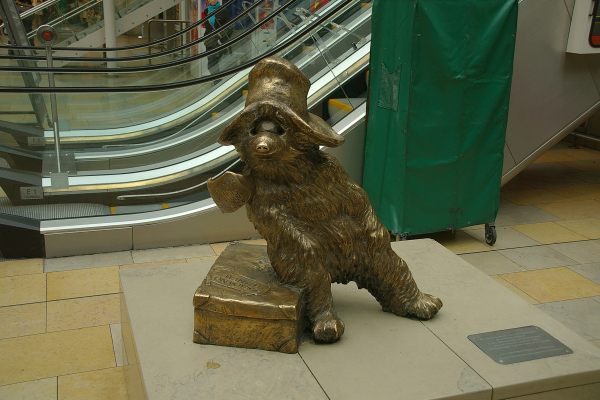London Is Still Paying Rent to the Queen on a Property Leased in 1211
In a small annual ceremony the city hands over an axe, a knife, 6 horseshoes, and 61 nails.

Earlier this October, at a ceremony at the Royal Courts of Justice, London paid its rent to the Queen. The ceremony proceeded much as it had for the past eight centuries. The city handed over a knife, an axe, six oversized horseshoes, and 61 nails to Barbara Janet Fontaine, the Queen’s Remembrancer, the oldest judicial position in England. The job was created in the 12th century to keep track of all that was owed to the crown.
In this case, the Remembrancer has presided over the rent owed on two pieces of property for a very long time—since 1235 in one case, and at least 1211 in the other. Every year, in this Ceremony of Quit Rents, the crown extracts its price from the city for a forge and a piece of moorland.
No one knows exactly where these two pieces of land are located anymore, but for hundreds of years the city has been paying rent on them. The rate, however, has not changed—the same objects have been presented for hundreds of years.
The Ceremony of Quit Rents is not well-publicized or much talked about: news services have covered it occasionally over the years, but the only official references I could find to this year’s ceremonies were a notice about a city-sponsored essay contest where the prize includes the privilege of attending the ceremony and an off-hand reference by the Lord Chief Justice of England and Wales.
But each fall, usually in October, the city and the crown perform the same exchange, for no particular reason other than that they always have.

The older rent is paid on a piece of land that’s supposed to be in the county of Shropshire, far from London. Known as “the Moors,” its exact location was lost long ago (although UPI reported in 1980 that London’s then-mayor Peter Gadsden picked a piece of land in the area and declared it the Moors in question).
The rent on the Moors is a billhook—a knife-like tool used in agriculture—and an axe. The billhook is supposed to be dull: one early instruction said it should “bend in green cheese,” Copley News Service reported in 1972. About three centuries after this rent was first recorded, though, the standard had changed: the billhook should be in such a condition that it could strike a one-year-old hazel stick and make “little or no mark.”
The axe, on the other hand, is supposed to be sharp. The current version of the ceremony tests both: First, the city representative uses the billhook to hack away at a pile of sticks. After that tool is proved ineffective, the axe gets its turn—and swipes cleanly through the same wood. “Good service,” the Remembrancer says.

The second rent is for a piece of land closer to home. In the neighborhood of what’s now the Royal Courts of Justice, back in the 13th century, the king held a tournament during which the knights needed help repairing their armor; the man who stepped up to do the work was then given a lease on the land to create a forge. (In a different version of the story, his job was to reshoe the horses of the Templar Knights. It’s possible both stories are true, since with the Temple Church just down the street, those knights would have been the farrier’s most obvious customers.)
The forge is long gone, but the rent remains the same—six horseshoes and 61 nails. The horseshoes, which are themselves centuries old, are giant. When presented with the horseshoes and nails, the Remembrancer says, “Good number.”
These two “quit rents” are not the only ones owed to the crown. London also owes a yearly token rent of 11 pounds on the “town of Southwark,” now a high-end area where Shakespeare’s Globe and the Tate Modern are located. Outside of London, landowners are on the hook for a variety of quit rents: a bucket of snow on demand, three red roses, a small French flag, a salmon spear. Some rents only kick in only if the king or queen visits: the renter must provide the crown with a bed of straw, in one agreement, and in another, the renter must offer a single white rose.

One landholder keeps his place only on the condition that, if the monarch shows up, he must “ride his horse into the sea, until the water reached the saddle girths, to meet his sovereign,” the Southam News Service reported. Another has to fight anyone the king wants him to. Possibly the best quit-rent ever conceived is this one: “three glasses of port on New Year’s Eve for the ghost of the King’s grandmother.”
For the most part, quit rents are relics of medieval agreements, but there was at least one quit rent agreement that was forged in the past century, in Lake Havasu City, Arizona. It started when the city imported a bridge from London—one which had spanned the Thames river and was auctioned off in the late 1960s. Robert McCulloch, Lake Havasu City’s founder, bought the bridge, and by the early ’70s, the bridge had been reinstalled in Arizona.
As a gift to London, during the dedication ceremony, McCulloch offered an acre of Arizona land, reports the Havasu News, and years later, when the city wanted to use that land for a visitor’s center, London agreed to lease it back to Lake Havasu. They settled on a token quit rent: a Kachina doll, a carved Hopi figure representing an immortal being.
















Follow us on Twitter to get the latest on the world's hidden wonders.
Like us on Facebook to get the latest on the world's hidden wonders.
Follow us on Twitter Like us on Facebook